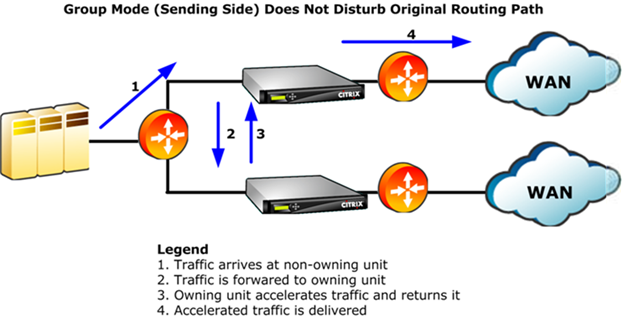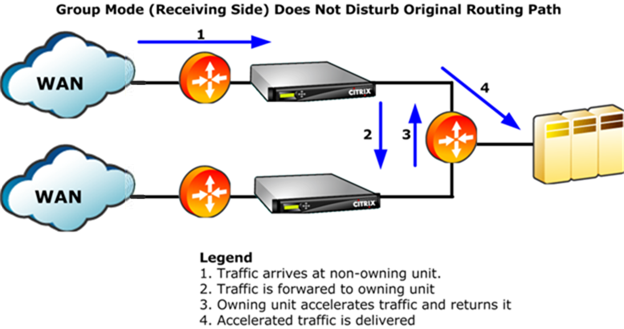How Group Mode Works
In group mode, the appliances that are part of the group each take ownership for a portion of the group’s connections. If a given appliance is the owner of a connection, it makes all the acceleration decisions about that connection and is responsible for compression, flow control, packet retransmission, and so on.
If an appliance receives a packet for a connection for which it is not the owner, it forwards the packet to the appliance that is the owner. The owner examines the packet, makes the appropriate acceleration decisions, and forwards any output packets back to the non-owning appliance. This process preserves the link selection made by the router, while allowing all packets in the connection to be managed by the owning appliance. For the routers, the introduction of the appliances has no consequences. The routers do not need to be reconfigured in any way, and the appliances do not need to understand the routing mechanism. They simply accept the routers’ forwarding decisions.
Figure 1. Sending-side Traffic in Group Mode

Figure 2. Receiving-side traffic flow in group mode

Group mode has two, user-selectable failure modes, which control how the group members interact with each other if one of them fails. The failure mode also determines whether the failed appliance’s bypass card opens (blocking traffic through the appliance) or remains closed (allowing traffic to pass through). The failure modes are:
Continue to accelerate- If a group member fails, its bypass card is opened and no traffic passes through the failed appliance. The result is presumably a fail-over if redundant links are used. Otherwise, the link is simply inaccessible. The other appliances in the group continue to accelerate. The usual hashing algorithm handles the changed conditions. (That is, the old hashing algorithm is used, and if the failed unit is indicated as the owner, a hashing algorithm based on the new, smaller group is applied. This preserves as many older connections as possible.)
Do not accelerate- If a group member fails, its bypass card closes, allowing traffic to pass through without acceleration. Because an unaccelerated path introduces asymmetric routing, the other members of the group also go into pass-through mode when they detect the failure.
The official version of this content is in English. Some of the Cloud Software Group documentation content is machine translated for your convenience only. Cloud Software Group has no control over machine-translated content, which may contain errors, inaccuracies or unsuitable language. No warranty of any kind, either expressed or implied, is made as to the accuracy, reliability, suitability, or correctness of any translations made from the English original into any other language, or that your Cloud Software Group product or service conforms to any machine translated content, and any warranty provided under the applicable end user license agreement or terms of service, or any other agreement with Cloud Software Group, that the product or service conforms with any documentation shall not apply to the extent that such documentation has been machine translated. Cloud Software Group will not be held responsible for any damage or issues that may arise from using machine-translated content.
DIESER DIENST KANN ÜBERSETZUNGEN ENTHALTEN, DIE VON GOOGLE BEREITGESTELLT WERDEN. GOOGLE LEHNT JEDE AUSDRÜCKLICHE ODER STILLSCHWEIGENDE GEWÄHRLEISTUNG IN BEZUG AUF DIE ÜBERSETZUNGEN AB, EINSCHLIESSLICH JEGLICHER GEWÄHRLEISTUNG DER GENAUIGKEIT, ZUVERLÄSSIGKEIT UND JEGLICHER STILLSCHWEIGENDEN GEWÄHRLEISTUNG DER MARKTGÄNGIGKEIT, DER EIGNUNG FÜR EINEN BESTIMMTEN ZWECK UND DER NICHTVERLETZUNG VON RECHTEN DRITTER.
CE SERVICE PEUT CONTENIR DES TRADUCTIONS FOURNIES PAR GOOGLE. GOOGLE EXCLUT TOUTE GARANTIE RELATIVE AUX TRADUCTIONS, EXPRESSE OU IMPLICITE, Y COMPRIS TOUTE GARANTIE D'EXACTITUDE, DE FIABILITÉ ET TOUTE GARANTIE IMPLICITE DE QUALITÉ MARCHANDE, D'ADÉQUATION À UN USAGE PARTICULIER ET D'ABSENCE DE CONTREFAÇON.
ESTE SERVICIO PUEDE CONTENER TRADUCCIONES CON TECNOLOGÍA DE GOOGLE. GOOGLE RENUNCIA A TODAS LAS GARANTÍAS RELACIONADAS CON LAS TRADUCCIONES, TANTO IMPLÍCITAS COMO EXPLÍCITAS, INCLUIDAS LAS GARANTÍAS DE EXACTITUD, FIABILIDAD Y OTRAS GARANTÍAS IMPLÍCITAS DE COMERCIABILIDAD, IDONEIDAD PARA UN FIN EN PARTICULAR Y AUSENCIA DE INFRACCIÓN DE DERECHOS.
本服务可能包含由 Google 提供技术支持的翻译。Google 对这些翻译内容不做任何明示或暗示的保证,包括对准确性、可靠性的任何保证以及对适销性、特定用途的适用性和非侵权性的任何暗示保证。
このサービスには、Google が提供する翻訳が含まれている可能性があります。Google は翻訳について、明示的か黙示的かを問わず、精度と信頼性に関するあらゆる保証、および商品性、特定目的への適合性、第三者の権利を侵害しないことに関するあらゆる黙示的保証を含め、一切保証しません。
ESTE SERVIÇO PODE CONTER TRADUÇÕES FORNECIDAS PELO GOOGLE. O GOOGLE SE EXIME DE TODAS AS GARANTIAS RELACIONADAS COM AS TRADUÇÕES, EXPRESSAS OU IMPLÍCITAS, INCLUINDO QUALQUER GARANTIA DE PRECISÃO, CONFIABILIDADE E QUALQUER GARANTIA IMPLÍCITA DE COMERCIALIZAÇÃO, ADEQUAÇÃO A UM PROPÓSITO ESPECÍFICO E NÃO INFRAÇÃO.

